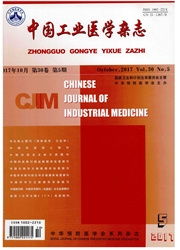

 中文摘要:
中文摘要:
目的探讨急性一氧化碳(CO)中毒家兔脑血流变学和凝血功能的变化及其在迟发性脑病(DEACMP)中的可能作用。方法腹腔注射CO制备急性中毒模型,使血HbCO浓度达50%以上持续30-36h,动态检测初次染毒后30min、6h及末次染毒后10min、6h、12h、18h、24h、3d、7d、14d颈静脉血的全血粘度(200^a-、100^a-、50^a-、3^a-)、血浆粘度、血浆纤维蛋白原(Fib)、血浆钙离子浓度([Ca^2+])、部分活化凝血酶原时间(APTT)、活化部分凝血酶时间(PT)的变化,并进行全血细胞分析。结果家兔末次染毒后10min,不同切变率下全血粘度即有显著降低,24h后则逐渐升高,14d时仍高于正常;末次染毒后10min至14d血浆纤维蛋白原及血浆粘度亦均高于对照组;部分活化凝血酶原时间、活化部分凝血酶时间于末次染毒后10min明显延长,3d后方大致恢复正常;血浆[Ca^2+]于末次染毒后10min明显下降,24h后恢复正常;红细胞(RBC)计数和红细胞压积(Hct)于末次染毒后18h升高,14d仍高于对照组。结论急性CO中毒早期,脑循环即出现血液浓缩和凝血功能异常,表现为RBC和Hct升高,血[Ca^2+]下降、凝血时间延长等;3d后凝血功能虽见恢复,但血液浓缩未见改善,RBC、Hot、全血粘度和血浆粘度持续升高,这些脑循环障碍的高危因素可能是急性CO中毒迟发性脑病发病的重要病理生理学基础。
 英文摘要:
英文摘要:
Objective To explore the hemorheological and hemocoagulative changes in cerebral circulation of rabbits with acute carbon monoxide (CO) poisoning and their possible roles in pathogenesis of delayed encephalopathy after acute CO poisoning. Methods The acute CO poisoning animal model was made by intraperitoneally injection with CO at regular interval, the levels of HbCO in blood might keep 50% or higher for 30~36 h, then the viscosity in whole blood (200^a- , 100^a- , 50^a- , 3^a-) and plasma, fibrinogen (Fib) and Ca^2+ levels in plasma, activated partial thromboplastin time (APTF) and prothrombin time ( PT), and whole blood cell counts were measured at 30 min and 6 h after first CO injection, and 10 min, 6 h, 12 h, 18 h, 24 h, and 3, 7 and 14 days after last injection of CO. Results The results showed that the whole blood viscosity at different shear rates decreased significandy at 10 min after last injection of CO, then gradually rose 24 h later and lasted for 14 days; the viscosity and fibrinogen in plasma were also increased since last injection of CO ; APTI' and PT were prolonged markedly from 10 min after last injection of CO, which recovered to normal range at the 3rd day after CO injection; while the concentration of Ca^2+ in plasma was declined since 10 min after last injection of CO, which recovered to normal range 24 h later; the RBC counts and hematocrit were also increased at 18 h after last injection of CO and were higher obviously than that in control even after 14 days. Conclusions The results showed that at the very beginning of acute CO poisoning, there were some abnormalities such as pachemia and dysfunction of hemoeoagulation despite that there was some ameliorated in hemocoagulation 3 days later, but the pachemia was still not recovered. All these changes in cerebral circulation might be the main physiopathological basis in the development of delayed encephalopathy caused by acute CO poisoning.
 同期刊论文项目
同期刊论文项目
 同项目期刊论文
同项目期刊论文
 期刊信息
期刊信息
